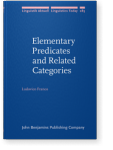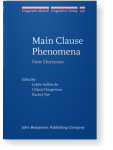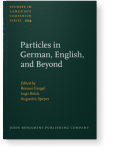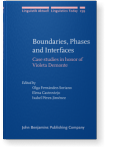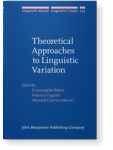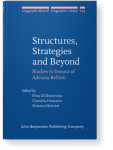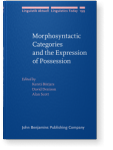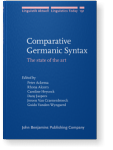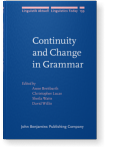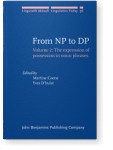Liliane Haegeman
List of John Benjamins publications for which Liliane Haegeman plays a role.
Book series
Title
Main Clause Phenomena: New Horizons
Edited by Lobke Aelbrecht, Liliane Haegeman and Rachel Nye
[Linguistik Aktuell/Linguistics Today, 190] 2012. vi, 433 pp.
Subjects Generative linguistics | Syntax | Theoretical linguistics
2023 Chapter 5. English rationale since and a reassessment of the typology of adverbial clauses Micro- and Macro-variation of Causal Clauses: Synchronic and Diachronic Insights, Jędrzejowski, Łukasz and Constanze Fleczoreck (eds.), pp. 129–166 | Chapter
This chapter examines the syntactic and semantic properties of English causal adverbial clauses, starting from the fact that the conjunctions since and as can both introduce either a temporal clause or a rationale clause. Where relevant, the material is supplemented with data from Dutch causal… read more
2022 Chapter 11. PP-internal particles in Dutch as evidence for PP-internal discourse structure Particles in German, English, and Beyond, Gergel, Remus, Ingo Reich and Augustin Speyer (eds.), pp. 297–322 | Chapter
Drawing on evidence from Dutch, this paper presents the new observation that discourse particles can not only appear at the level of CP, but also inside the PP domain. In particular, we demonstrate that Dutch dan can receive a non-temporal interpretation, and in this reading dan can appear as a… read more
2021 Chapter 4. Invariant die and adverbial resumption in the Ghent dialect Current Issues in Syntactic Cartography: A crosslinguistic perspective, Si, Fuzhen and Luigi Rizzi (eds.), pp. 53–110 | Chapter
This chapter focusses on the apparent V3 pattern in (1), which is salient with some speakers of the Ghent dialect: an initial adverbial constituent in the root clause, vroeger (‘formerly’), is separated from the finite verb by an optional ‘pleonastic’ (Vanacker 1980) element, die. The element… read more
2017 Syntacticizing blends: The case of English wh-raising Boundaries, Phases and Interfaces: Case studies in honor of Violeta Demonte, Fernández-Soriano, Olga, Elena Castroviejo Miró and Isabel Pérez-Jiménez (eds.), pp. 25–46 | Chapter
This paper aims at analysing English structures in which a wh-moved subject triggers agreement both in the clause it is extracted from and in the immediately higher clause. This pattern is only accepted by some native speakers, and it is also attested in corpora. Although the relevant structures… read more
2017 Unspeakable sentences: Subject omission in written registers: a cartographic analysis Register Variation and Syntactic Theory, Massam, Diane and Tim Stowell (eds.), pp. 229–250 | Article
The empirical focus of this paper is register based subject omission in English. On the basis of a range of empirical data (including naturally occurring examples) the paper first dispels a number of common misconceptions about the phenomenon such as the idea that (i) this phenomenon is only… read more
2016 Deriving idiolectal variation: English wh-raising Theoretical Approaches to Linguistic Variation, Bidese, Ermenegildo, Federica Cognola and Manuela Caterina Moroni (eds.), pp. 145–176 | Article
The focus of this paper is on apparent cases of subject-to-subject raising out of finite clauses in English, which are accepted as (fully) grammatical by a minority of native speakers. The basic pattern involves a bi-clausal structure in which a displaced subject triggers agreement in both the… read more
2016 Finiteness and response particles in West Flemish Finiteness Matters: On finiteness-related phenomena in natural languages, Eide, Kristin Melum (ed.), pp. 211–254 | Article
The empirical focus of the chapter is the morphosyntax of the morphologically marked response particles ja and neen in the Lapscheure dialect of West Flemish. Building on Krifka (2013)’s analysis of the corresponding German response particles ja/nein as TP pro-forms, we analyze morphologically… read more
2015 Preface Structures, Strategies and Beyond: Studies in honour of Adriana Belletti, Di Domenico, Elisa, Cornelia Hamann and Simona Matteini (eds.), pp. ix–x | Article
2015 The cartography of yes and no in West Flemish Discourse-oriented Syntax, Bayer, Josef, Roland Hinterhölzl and Andreas Trotzke (eds.), pp. 175–210 | Article
We make an in-depth study of the response particles ja/nee (‘yes/no’) in the Lapscheure dialect of Dutch. These particles show overt phi-feature marking corresponding to what would be the subject of a response clause. Additionally, in ‘reversal answers’, the particles bear additional morphology. We… read more
2015 Be careful how you use the left periphery Structures, Strategies and Beyond: Studies in honour of Adriana Belletti, Di Domenico, Elisa, Cornelia Hamann and Simona Matteini (eds.), pp. 135–162 | Article
The paper evaluates two left-peripheral analyses of gapping: one cartographic analysis, and a second Minimalist analysis, which aligns the left-peripheral movement of gapping with fronting for contrastive effects. It is shown that there are similar problems for both these analyses, in particular… read more
2014 Against the matrix left peripheral analysis of English it-clefts Romance Languages and Linguistic Theory 2012: Selected papers from 'Going Romance' Leuven 2012, Lahousse, Karen and Stefania Marzo (eds.), pp. 91–108 | Article
In the wake of the proposals for the articulated left periphery (Rizzi 1997), Meinunger (1997, 1998), Frascarelli & Ramaglia (2009, 2013) and Sleeman (2011) assign to it-clefts a representation modeled on that of wh-interrogatives and of focus fronting. This paper first outlines one precise… read more
2013 Two prenominal possessors in West Flemish Morphosyntactic Categories and the Expression of Possession, Börjars, Kersti, David Denison and Alan K. Scott (eds.), pp. 219–252 | Article
This chapter provides an inventory of the syntactic properties of prenominal possessors in West Flemish (WF). WF has two prenominal possessor patterns: a. Valère zenen oto b. Valère sen oto Valère his car Valère se carIn (a) the possessor Valère is doubled by the possessive pronoun zenen,… read more
2012 Main Clause Phenomena and the privilege of the root Main Clause Phenomena: New Horizons, Aelbrecht, Lobke, Liliane Haegeman and Rachel Nye (eds.), pp. 1–20 | Article
2012 Conditional clauses, Main Clause Phenomena and the syntax of polarity emphasis Comparative Germanic Syntax: The state of the art, Ackema, Peter, Rhona Alcorn, Caroline Heycock, Dany Jaspers, Jeroen van Craenenbroeck and Guido Vanden Wyngaerd (eds.), pp. 133–168 | Article
This paper addresses two properties of conditional clauses: (i) their incompatibility with Main Clause Phenomena (MCP), exemplified by English argument fronting, and (ii) the unavailability of Speaker Oriented Adverbs (Ernst 2009) (SpOAs). The paper elaborates the hypothesis (Bhatt & Pancheva 2002,… read more
2012 The syntax of MCP: Deriving the truncation account Main Clause Phenomena: New Horizons, Aelbrecht, Lobke, Liliane Haegeman and Rachel Nye (eds.), pp. 113–134 | Article
This paper proposes that the restricted distribution of MCP follows from locality conditions on movement. The focus is the well-known absence of argument fronting in English adverbial clauses, but the account extends naturally to other clause types and to other MCP. Underlying most syntactic… read more
2010 Continuity is change: The long tail of Jespersen’s cycle in Flemish Continuity and Change in Grammar, Breitbarth, Anne, Christopher Lucas, Sheila Watts and David Willis (eds.), pp. 61–76 | Article
All West Germanic languages have completed Jespersen’s Cycle, replacing a preverbal negation marker (stage I) with a post-verbal one (stage III) after a period of transition during which the two could co-occur (stage II). Only the Flemish dialects have maintained the old preverbal marker to some… read more
2003 8. The external possessor construction in West Flemish From NP to DP: Volume 2: The expression of possession in noun phrases, Coene, Martine and Yves D’hulst (eds.), pp. 221–256 | Article
2000 Remnant Movement and OV Order The Derivation of VO and OV, Svenonius, Peter (ed.), pp. 69 ff. | Article
1997 The Syntax of N-Words and the Neg Criterion Negation and Polarity: Syntax and semantics. Selected papers from the colloquium Negation: Syntax and Semantics. Ottawa, 11–13 May 1995, Forget, Danielle, Paul Hirschbühler, France Martineau and María Luisa Rivero (eds.), pp. 115 ff. | Article
1996 The Typology of Syntactic Positions: L-Relatedness and the A/Ā -distinction Minimal Ideas: Syntactic studies in the minimalist framework, Abraham, Werner, Samuel David Epstein, Höskuldur Thráinsson and C. Jan-Wouter Zwart (eds.), pp. 141–165 | Article
1996 Root Infinitives, Clitics and Truncated Structures Generative Perspectives on Language Acquisition: Empirical findings, theoretical considerations and crosslinguistic comparisons, Clahsen, Harald (ed.), pp. 271 ff. | Article
